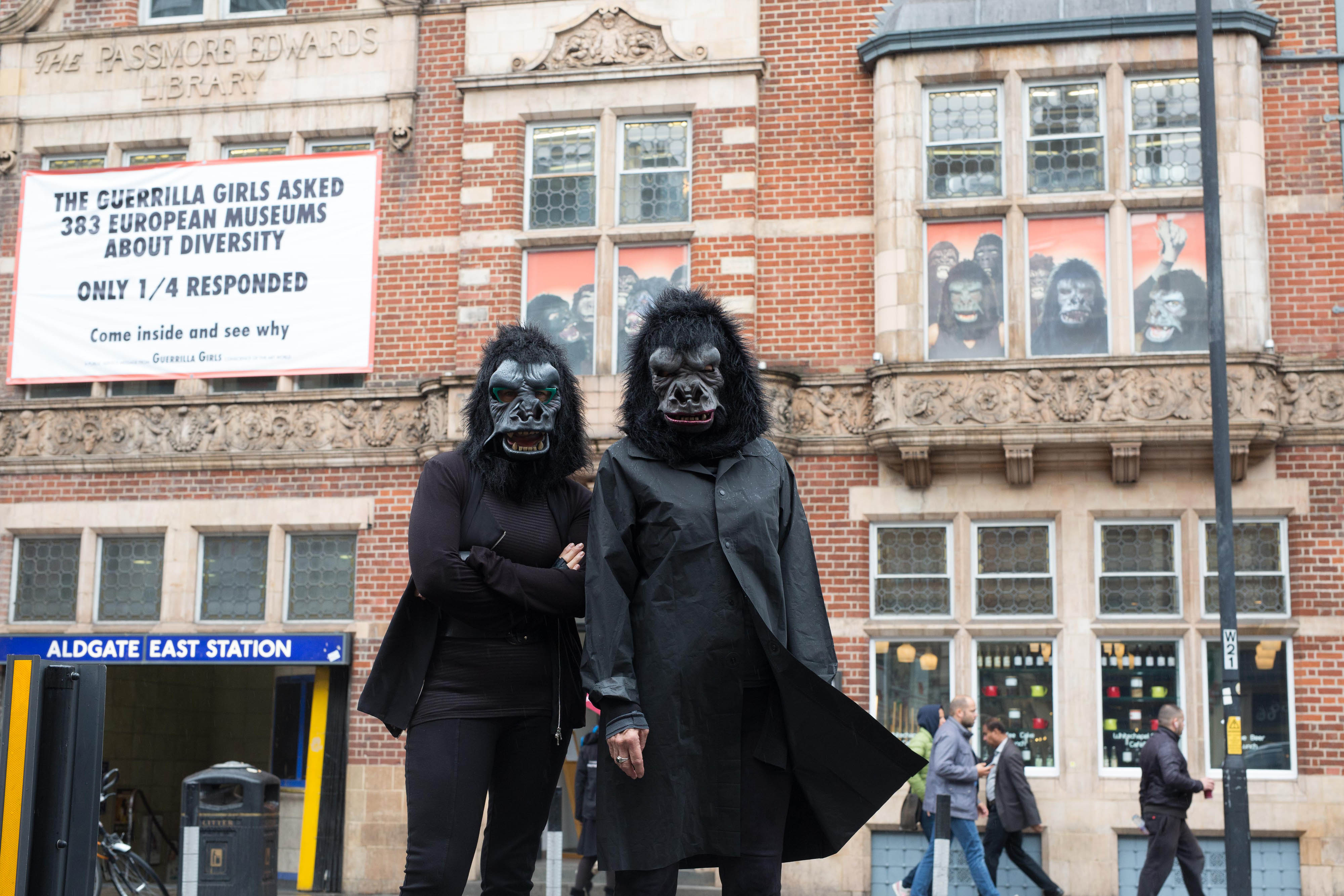
For a sphere that has spent decades theorizing (and frequently celebrating) its own progressiveness, the art world is still a remarkably sexist place.
Given the grinding struggle that has become the quest for diversity in the arts, it was refreshing to see the latest exhibition commissioned by the Whitechapel Gallery. The institutions’s Archive Gallery is hosting the first dedicated UK show of infamous feminist art collective, Guerrilla Girls, titled “Is it even worse in Europe?”
The collective formed in New York in 1985 in response to the low status and visibility of female artists. As the self-styled “conscience of the art world,” Guerrilla Girls began running “weenie counts” and presenting their findings in witty campaigns, frequently disseminated using guerrilla marketing tactics like fly-posting, and strategies deployed in advertising and pop culture to target museums, dealers, and curators complicit in art world misogyny.
Guerrilla Girls, DO WOMEN STILL HAVE TO BE NAKED TO GET INTO THE MET. MUSEUM? (2012). Photo courtesy the Guerrilla Girls.
Three decades on their remit has adapted to encompass racial diversity and representation of gender non-conforming artists, and “Is it even worse in Europe?”showcases 10 new posters created by the collective to explore these topics.
The show’s title is a riff on one of their early campaigns. But the 1986 statement was based on anecdotal evidence about Europe, rather than the kind of data they had been collecting in the US. Thirty years on, the girls reformulated it as a query to be properly answered, by inviting 383 European museum directors to respond to 14 questions about diversity in their institutions.
From “Guerrilla Girls: Is it Even Worse in Europe?” Photo Naomi Rea.
Selections from the answers and the Girls’ customary caustic commentary are now presented in posters hung in the Archive Gallery over walls papered with copies of every completed questionnaire, and the floor is waggishly carpeted with a poster naming-and-shaming those institutions that failed to respond.
Looking over the copies—some typed, others handwritten—it was amusing to note the-variety in the tone of the comments, from the simple, careless answers of smaller galleries to the defensive rejoinders obscured in the administrative jargon of larger institutions.
Identities masked by their now-familiar gorilla guises and artist pseudonyms, two of the founding Guerrilla Girls, Frida Kahlo and Käthe Kollwitz, joined exhibition curators Nayia Yiakoumaki and Xabier Arakistain for a talk in the Zilkha Auditorium this past Friday, following the exhibition’s press preview.
The artists reflected on how the art landscape has changed for women since they began, explaining that it used to be unusual for a gallery to display any female artists.
“Dealers and gallerists would say something like ‘women and artists of colour just don’t make the kind of work that’s part of the art world dialogue.’ No one would be so stupid as to say that sort of stuff anymore. That has changed forever,” said Kollwitz.
From “Guerrilla Girls: Is it Even Worse in Europe?” Photo Naomi Rea.
But it’s not all getting better. One of the concerns that emerged from the discussion was the phenomenon of what the Guerrilla Girls dubbed the “bad behavior” of American institutions—the undue influence exerted by wealthy trustees—seeping into the practices of the European art world.
Although many European museums are public institutions, Kollwitz explained that the American model is spreading, saying, “The privatization of the public institution is a growing, creeping problem. And we just ask the larger question: can we allow this system to tell us our history? And what are the problems with a history that is created by the taste, and the money, and the wealth, and the power, of a few?”
It’s important to remember that Guerrilla Girls are artists, not social scientists, so the answer to the question posed in the exhibition’s title seems not to matter as much as the fact that it is being asked. What stood out was not a comparison of diversity in European and American institutions, but the possibilities generated by the gathering of data about diversity.
For many of the respondents, this marked their first time collecting this kind of data. Numbers can better illustrate a dearth in diversity than anecdotal evidence, so the campaign’s output is useful not just for drawing attention to the gender and racial disparities in the art world now, but also for measuring the persistence of these issues.
Guerrilla Girls, It’s even worse in Europe. (1986). Photo courtesy the Guerrilla Girls.
It is worth nothing something co-curator Xabier Arakistain stressed: that this project was an answer to an institutional invitation, happening at a time in which feminism is being institutionalized. The fact that this exhibition is happening at all is an encouraging sign of women’s improved status in the art world, so perhaps the Whitechapel should be commended for its courage in inviting the scrutiny of the collective, as well as for commissioning the first study of diversity in the European art world, imperfect though it may be. But let’s not forget that there’s still a lot of work to be done.
“The Guerrilla Girls: Is It Even Worse in Europe?” is on view at the Whitechapel Gallery, London, from October 1, 2016 – March 5, 2017.